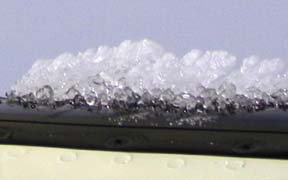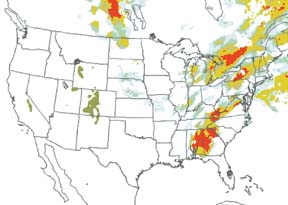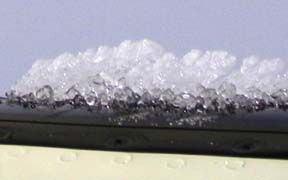
By Ray Leis
Some pilots start worrying about ice as soon as they see the first traces of it on the wings, on the windshield or on a strut. And indeed they should: The NTSB lists 40 to 50 accidents/incidents every winter resulting from airframe icing. In addition, about the same number result from winters effects on induction systems-if the engine cant breathe, it cant make power.
The good news is that most of these accidents are preventable. If you take off with ice or snow on the airplane, youre both braver and less intelligent than many. Airborne, once the ice is there, something probably needs to be done about it. That said, there are a number of pilots out there who have picked up more than a trace of ice and lived to tell about it. How did they get away with it? How much ice is enough, and how much is too much?
On The Ground
One thing that winter pilots know is they can easily become a test pilot for an entirely new and unknown airfoil, one reshaped by ice, snow or frost. Simply put, its foolish to take off with any contamination. You have the opportunity to remove the ice/snow/frost before takeff, why not use it? Similarly, once airborne, the contamination rarely will disappear, unless you know youre launching into an inversion and flying into warmer air.
When your airplane is parked outside on a clear, cold night, frost will form on its upper surfaces. It doesnt appear to amount to much, but most reported frost-on-the-wings accidents show that the airplane does get off the ground and into ground effect-about one wing span high-but cant climb any further. A trip into the trees ensues. In these cases, the wings top surface is simply too rough to develop efficient lift. It doesnt look too different at first glance, but that surface-up close-is a rough mass of jagged ice crystals, and they disrupt the airflow across the wing. Write this down: Any ice, snow or frost must be removed before attempting any takeoff.
How do we accomplish that? We can use the FBOs approved de-icing fluid and equipment or we can break it up and brush it off. We also could move the aircraft into a heated hangar and let it thaw. If we choose the heated hangar, we need to make sure all water is removed from the surfaces. If it isnt frozen on the ground, it can solidify once airborne, after seeping into hidden locations. On the ground, before takeoff, any ice is too much.
Out Of There
Once airborne, know that the big secret to dealing with in-flight icing is not really a secret. In fact, its very simple: Always have a way out. This is true even if you are equipped to fly into known icing conditions. To do this, you need a thorough weather briefing, including a firm understanding of the air mass characteristics where youll be flying. The sidebar at right lists eight questions to ask during your pre-flight briefing-feel free to add your own.
For example, can you descend to warmer temperatures, if you encounter ice en route? Will there be sufficient terrain clearance? If you climb to clear, cold air on top, can you descend and land safely at your destination or alternate? If no is the answer to these questions, cancel the flight.
But ice is where you find it-many a pilot has encountered the stuff well away from where it was forecast to be. The most severe in-flight aircraft structural conditions can occur when the temperature is 0 degrees C and colder. Structural icing, of course, is found in conditions of visible moisture.
Departing
Are you planning to climb through an icing layer? Its a workable way to handle an icing forecast, if you have Pireps detailing the cloud tops and you are flying a known-ice-approved airplane.

Lacking that equipment, your plan to get on top might not work. If ATC delays your climb and ice begins to accumulate, let the controller know immediately. If he isnt able to give you a higher altitude, ask for a vector away from traffic to climb.
How much ice is too much on departure? If climbing into clear air, we might be willing to accept a 10-percent hit on airspeed and/or climb rate. Anything more than that drastically prolongs our exposure, making the situation worse. Even if you reach your cruising altitude, the ice might not sublimate as quickly as youd like. That can make your trip a long, miserable one and raise range/endurance issues. Diverting to an ice-free bolt-hole might be the answer. It depends.
En Route
At your cruising altitude, you should have more options than you did right after takeoff. A change in altitude can both get you out of an ice-laden cloud or put you in warmer air. But dont wait too long to request a climb since your climb rate will suffer.
Should you climb or descend to get out of the icing conditions? The correct answer has its foundation in several factors. For example, whats underneath you? If youre already at or near the minimum altitude for the terrain, going down is a bad idea. Too, there could be more ice lower. Climbing is usually best, since terrain is not a factor and it leaves you more options. Refer to your pre-flight briefing to learn how high youll have to climb.
How much ice is too much at cruising altitude? Again, it depends. A trace on the windshield or leading edge probably isnt worth worrying about in a high-performance retractable. Again, our rule of thumb is based on the airplanes performance: A 10-percent hit on cruise speed is too much ice. In an underpowered fixed-gear single, wed be a lot more careful, and might not have taken off in the first place.
Approach And Landing
When making the landing approach with an iced-up airplane, you have a number of new problems. The stall speed and general handling characteristics are going to be different, perhaps radically so. Ice has remodeled the wing and control airfoils. You are your own test pilot. This iced-up model hasnt been tested before.
Generally, the thicker the ice on the airfoil surfaces, the higher the approach speed should be. Certainly dont make any abrupt or large changes in pitch, power, bank or flap setting, during the approach or the landing. Youll need to fly the airplane onto the runway. The higher landing speed may greatly increase the distance that it takes to stop. Add a lot more distance cushion if the runway is covered with snow or ice.
Landing in marginal surface conditions is pretty much a reversal of the care you took on the takeoff roll. Keep the crosswind aileron correction in; keep straight on the runway; dont get in any hurry to clean up the flaps, cowl flaps or lights until you are off the runway safely. Taxi very carefully to parking.
Conclusion
How much ice is too much? It depends-on the airplane, on the environment, on the pilot and on the mission. A lightly loaded rocket ship might be unfazed by a half-inch or so. A heavy Skyhawk might stagger through the sky after only a trace.
A little ice might not be a problem if you have options and if theres no strong probability of accumulating more. That half-inch of clear is much less of an issue in VMC at 15,000 feet in your Baron than it is when your Warrior is being vectored for an ILS through an icing layer followed by a likely miss. But now you know enough about where the icing is and how to handle the airplane that picking up a little ice isnt going to be a crisis. Right?
Also With This Article
“Eight Questions For Your Briefer”
“Pre-Flight And Ground Ops”
“Landing With Ice”
-Ray Leis holds ATP, CFII, Commercial and glider certificates and, in an earlier life, was a Designated Pilot Examiner for all ratings.




